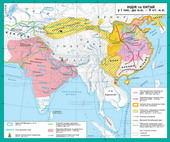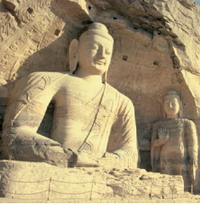§ 28. CultureAncient China
1. Scientific knowledge andgreat inventions of the Chinese people
Great strides in ancient Chinese astronomy. They could providelunar and solar eclipse even the appearance of comets. They first found a spot onSun.
I wonder
World ancient Chinese astronomers imagined a huge egg.Earth was similar to the yolk and shell to the sky. Were attached to the sky lights,which together with the sky turning around the Earth. Courtiers were astrologershoroscopes and other astrological predictions.
Chinese mathematicians knew decimal fractions, for the first time ever inventednegative numbers.
In ancient China, the compass was invented. It consisted of a squareiron plate and a magnetic "spoons" that is freely rotated onpolished surface of the plate. Handle "spoons" always on showsouth. In the II century. BC was invented in China Globe.
The most important invention was the Chinese paper. Its made of rags,tree bark and bamboo. In China, first learned to make thin silktissue. In ancient times, Chinese doctors recommended their patients healingencouraging product - tea. Later it began to take a drink.
I wonder
Production of paper in China.
First, bamboo (cloth or tree bark) SOAKED in water tosoften. Then it podribnyuvaly and boiler in the boiler, thus receivingread a paper weight. In this mass worker dipped a thin foil, whichgathered in the tape fiber pulp. The mesh vidzhymaly under pressure and dried.Dried paper separated from the grid.
The Chinese invented gunpowder. They used it for arrangingfireworks on holidays. In 134, the BC scientist Zhang Heng invented the world's first seismograph - a device fordetermination of soil vibrations (earthquakes).
It was made of brass in the form of barrels of 8 dragons on itsurface. Dragons pointed to all corners of the world, and sitting around with frogsopen mouths. In the mouth of the dragon was on the ball. While fluctuationssoil from the jaws of a dragon vykochuvalas ball and dropped into the mouth in zhabi. Sodetermined the direction of the earthquake center.
The most prominent Chinese historian, was very Qian,who lived at the end of II - at the beginning and art. BC His workcalledШі Ji"(Historical note). Being a public officer, Sima Qian traveled around almost allcountry and collected many written sources. He recorded the stories of participants andwitness the recent historical events, and oral narratives about the distant past. Inhis "Historical Notes" Sima Qian outlined the history of China from ancient times to the end of II century.BC
2. Writing
Writing in China dates back to ancient times (III millennium BC)Archaeologists have found many ancient objects with inscriptions: these vessels, bonesdivination, turtle shell. During Dynasty Qinwas introduced only for the whole country writing. It has survived to our daysalmost unchanged.
Characters in Chinese script is hieroglyphics. Each charactermeant a single word. In Old Chinese Conventions used10 thousand characters. Punctuation is not there. Therefore, trainingcredentials required much time and effort. Originally written in Chinese armorskulls, animal bones and bronze vessels.
In pre BC Chinese writing brush onplates of bamboo. Vmochaly brush in lacquer made from tree sap. Bywith leather or silk cord bamboo boards linked in particularbook. This book could hold a visa, and even more.
Subsequently, the Chinese began to use writing for silk ribbon.
They were easy to write, but at that time, silk was very expensive material.
End of the pre BC began to write on paper. Paper wasmuch cheaper than silk and more comfortable than the bamboo boards. Kanjiwriting columns from top to bottom.
I wonder
Nowadays such complex characters accumulated tens of thousands. Sonow learn Chinese charter harder than learning to speak. But modernChinese do not want to switch between characters in the alphabet (writing easier).There are two main reasons.
First, had to rewrite all the great Chinese literature.Second, the pronunciation of some words in different parts of China is very different, thoughthey recorded the same way. The same character is read in the north chyiAnd in the south - that. Therefore, in the Ukrainian language appearedword tea, and in Western European languages the word is pronounced or those that.
3.Konfutsiy and his teachings
Confucius was born in 551, the BC The family to which he belonged,was once a noble and rich, then poor and no longer occupied the formersituation. In spite of their low abundance, small Kun (Confucius)carefully studied. When the boy grew, he was appointed governor and state pantrieslands. He performed his duties conscientiously. He also collected money transfersof antiquity. Already in 1930 created the first Confucius in China private school.The glory of his mind and good education spread throughout the country. He became a respectedteacher. Of all of the young men came to hear his instructions and becomestudents.
Confucius taught that every citizenmust comply strictly with "ritual and ceremonial, rasprostranyalas that follow ancient folk traditions, established norms of behavior.Only then can the country achieve prosperity and harmony. First, assage taught, you must show deference to his parents and older.After a strong family - is key to a strong state.
Confucius taught that the ruler should be captain, officer - officer,father - father, son - son.
"Pay good for good and evil by viddyachuyte to justice,"- Confucius lectured.
Confucius traveled the country trying to convince the rulers rightlymanage people. Winners greeted him with honors, but not alwayskept his counsel.
Confucius taught his disciples the doctrine in the form of conversations with their teacher.Later they were collected in 13 books. The most prominent of them is "Lunyuy"(" Conversations and teacher judgments Kun Ji (Confucius) with many students).
Confucius died at the age of 73. His teachings spread throughout China.
4. Taoism
Widespread in ancient China has become the doctrine of Taoism. The word"Taoism" is derived from the worddao"which means "way" or "basis of the world." The emergence of thisdoctrine associated with the name of the ancient sage - Lao Ji,who lived in the VI-V century. BC In the translation of his name means oldphilosopher. Legend tells that he was born with gray hair and so wasnamed "Lao" - "old." Value and popularity Lao Ji consider the second after sage Confucius of China. Hisdoctrine set forth in the famous book "Dao De Jing"which means "The Book of way and the good case ".Taoist were against inequality in society and denounced the war."A good army - a tool that generates misery, hate it all ...Elevate a victory - it means killing the people rejoice. Those who rejoiceto murder people can not win sympathy in the country ... When killedmany people will be distressed by this cry. We must celebrate victoryfuneral procession "- Lao stated Ji. Heopposed the wealth and luxury nobility, extortion power, which proved to the peoplepoverty. Great sage rulers condemned the brutal and arbitrary officials.
Lao Ji put forward the principlenediyannya.On the one hand, it expressed a request to the rulers oppress the people and not give himdevelop freely. On the other - "nediyannya"called for the people back to nature, to the "golden age",when there were bloody wars and disputes, which are torn society.
Taoist rejected sacrifice sky, earth, rivers, mountainsetc.. Taoist monks were skilled magicians, mahamy, shamans and carefullytreated with folk traditions and ceremonies.
5.Mystetstvo
Ancient Chinese people have achieved great skill in handling copper and bronze.These are the materials of archeological excavations. Bronze ware decoratedgold, silver, precious stones. On vessels depicted hunting scenesand military campaigns.
In ancient China, houses built of wood, and were not preservedto our time. However, have survived their clay models. Chinese architectscreated a unique style multilevel house.
To our great relief are preserved on tomb stone slabs.Most of these paintings portrayed the harvest, hunting. The walls of the cryptfuneral decorated with frescoes. They portrayed everyday picturessuch travel in chariots.
Reached us many songs of ancient China, which were written in"Book of Songs" (Ші Jing).
Here is one of the following songs: "Cracking,resonate with horses, plyhayut, plyhayut grasshoppers. I do not see her lover - the heart experienced sadnessbeats. But only see him - once the heart at rest. Go up to the southmountain fern zirvu there. I do not see her lover - the heart experienced sadness sad, sad. Andonly see him and just meet him - just glad heart. Go up to the southmountain, there Narva wild lentils. I do not see her lover - my heart aches with grief.But only see him and meet him only - once the heart at rest.
Important role inAncient China was given dancing and music.
Questions and Tasks
1. Which scientific knowledgedeveloped in ancient China?
2. How similar and different teachings of Confucius, Lao Jiand Buddha? Which of them is closer to one another?
3. CompareChinese character writing with the other countries of the Ancient East. WhatChinese books, different from "books" of Egypt andSecond anniversary?
4. Spread the wordArts of Ancient China.
5. WhyAncient China born the same scientific knowledge, as in other countries of the AncientEast?
 English
English

























